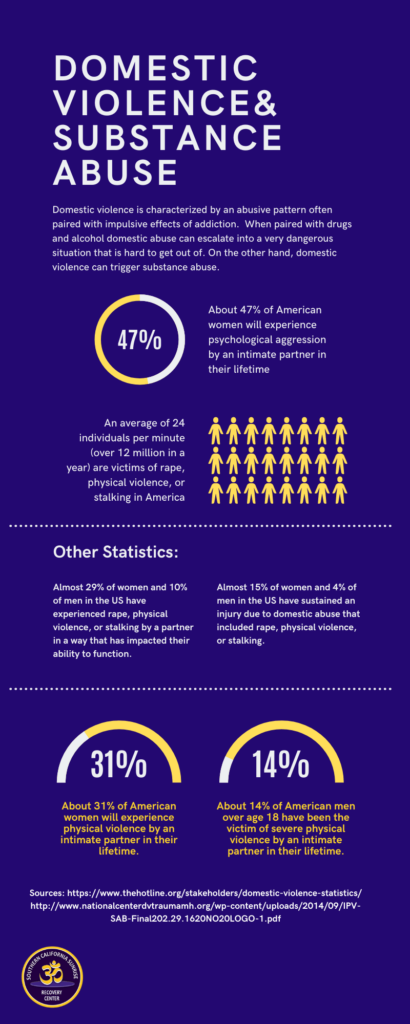Domestic Violence and Substance Abuse
Domestic violence is characterized by an abusive pattern often paired with impulsive effects of addiction. When paired with drugs and alcohol domestic abuse can escalate into a very dangerous situation that is hard to get out of. On the other hand, domestic violence can trigger substance abuse. To learn more about the relationship between the two, continue reading or call us today for help.
Table of Contents
Domestic violence and addiction can occur at the same time. Individuals who abuse substances are more likely to enter into relationships that involve domestic abuse, and victims of domestic violence are more likely to develop a substance use disorder. 1
If you believe you or a loved one is a victim of domestic abuse and suffering from an addiction to drugs or alcohol it is important to understand what domestic violence is, the different types of domestic violence, the signs and effects of domestic violence, the relationship between domestic violence and substance abuse, and the signs of addiction.
What is Domestic Violence
Domestic violence, also called “domestic violence” or “intimate partner violence,” refers to behavioral patterns in intimate relationships that are characterized by maintaining power and control over a partner.2
In heterosexual relationships with domestic violence, men are often the abusers, and women are often the victims.3 However, women may also be the abuser in a partnership where domestic abuse is present.
Domestic abuse can include physical, sexual, emotional, economic, or psychological behaviors or harmful threats to an intimate partner. These behaviors and threats often scare, intimidate, terrorize, manipulate, hurt, humiliate, blame, injure, or wound the victim.3
Abusive tactics like intimidation, threats, physical or sexual violence, isolation, economic abuse, stalking, psychological abuse, and coercion related to mental health and substance use are commonly used to enforce power and control in these relationships.3
Domestic violence can occur in any relationship regardless of race, age, sexual orientation, socioeconomic status, education level, religion, or gender. It also occurs in various kinds of relationships, including married couples, living together, or dating.2
Other household members, including a child or other relative, can be victims of domestic abuse, in which the abuser exerts power or control over the victim. Incidents of this kind of abuse are not usually isolated and can increase in frequency and severity. In some cases, it may result in severe injury or death.2
For some individuals, domestic abuse is their first experience with abuse, and others have experienced additional victimizing trauma in their lifetime. Survivors of domestic violence often experience many forms of interpersonal trauma, including childhood abuse or neglect, sexual assault, intergenerational violence, community violence, and witnessing violence as a child. 7
There is often a cycle of abuse in relationships where domestic violence is present. If abuse happens once, it will usually happen again and can progress into a cycle with different stages of abuse. 4
The first stage is build-up, in which tension increases and verbal, emotional, and financial abuse may be present. The “stand over” stage might follow this. In this stage, the behavior gets worse, and the victim begins to feel as though they are “walking on eggshells.” 4
The next stage is the explosion, in which the abuser may become violent. After this stage, the abuser might feel remorse and shame and try to justify their behavior. They may also become distant or promise not to engage in the behavior again.4
The couple might then move into the honeymoon stage, in which they are both in denial about the abuse and how bad it is. This final stage is usually followed by another cycle of abuse. 4
- About 31% of American women will experience physical violence by an intimate partner in their lifetime 3
- An average of 24 people per minute are victims of rape, physical violence or stalking by an intimate partner in the United States — more than 12 million women and men over the course of a single year.5
- About 47% of American women will experience psychological aggression by an intimate partner in their lifetime3
- Nearly 3 in 10 women (29%) and 1 in 10 men (10%) in the US have experienced rape, physical violence, and/or stalking by a partner and reported it having a related impact on their functioning.5
- Just under 15% of women (14.8%) and 4% of men in the US have been injured as a result of intimate partner violence that included rape, physical violence, and/or stalking by an intimate partner. 5
- 1 in 4 women (24.3%) and 1 in 7 men (13.8%) aged 18 and older in the US have been the victim of severe physical violence by an intimate partner in their lifetime. 5
- Intimate partner violence alone affects more than 12 million people every year. 5
- Over 1 in 3 women (35.6%) and 1 in 4 men (28.5%) in the US have experienced rape, physical violence, and/or stalking by an intimate partner in their lifetime. 5
Types of Domestic Violence
Physical Abuse
Physical abuse includes hitting, biting, slapping, battering, shoving, punching, pulling hair, burning, cutting, pinching, or any other violent behavior exerted on the victim. 6 Physical abuse can also include throwing objects, destroying property, forcing drug or alcohol use on the victim, and denying the victim food or medical treatment. 6,4
Sexual Abuse
Sexual abuse occurs when the abuser coerces the victim into engaging in sexual contact or sexual behavior without their consent. 6 It can also include sexual threats and insults, restricting access to contraception, or refusing to wear a condom. 4
Examples of sexual abuse include marital rape, attacking sexual body parts, physical violence followed by forced sex, sexually demeaning the victim, and telling sexual jokes at the victim’s expense. 6
Verbal Abuse
Verbal abuse includes intimidation, verbal attacks, threats, insults, name-calling, yelling, or humiliation. The abuser may bring up body shape, sexuality, intelligence, or even parental ability. 4
Emotional Abuse
Emotional abuse includes invalidating or deflating the victim’s self-esteem and self-worth. Examples of this kind of abuse include constant criticism, name-calling, negatively impacting the victim’s relationship with their children, and interfering with the victim’s abilities. 6
Social Isolation
Social isolation occurs when the abuser isolates the victim from their family and friends by forbidding or preventing contact and ongoing rudeness to family and friends. For example, the abuser might encourage the victim to move away from family and employment opportunities. 4
Economic Abuse
Economic abuse occurs when the abuser seeks to control the victim’s financial resources, withhold access to funds, or prohibit them from going to school or work to ensure they are financially reliant. 6
The abuser may also withhold access to finances by providing a small allowance to victims, restricting them from accessing bank accounts, and hiding assets. 4
Psychological Abuse
Psychological abuse occurs when the abuser invokes fear through intimidation; threatens to physically harm themselves, the victim, children, family or friends, or pets; destroys property; injures pets; isolates the victim from family and loved ones; prohibits the victim from attending school or work. 6
This kind of abuse may include blaming or ignoring the victim, treating them as inferior, labeling their behavior as inappropriate, questioning the victim’s sense of reality, and emotional blackmail. 4
Spiritual Abuse
Spiritual abuse occurs when the abuser ridicules the victim’s religious beliefs and culture or prevents them from engaging with their religion or cultural group. 4
Child and Elder Abuse
Child and elder abuse refers to physical abuse, sexual abuse, verbal abuse, emotional abuse, or neglect of a child or elder. 4
Neglect
Neglect includes failing to meet the basic physical and psychological needs of someone who needs it, like a child. Examples include failing to protect the victim from physical harm or danger, preventing them from getting necessary medical care, or remaining unresponsive to their basic emotional needs. 4
Stalking
Stalking includes following, spying, watching, and harassing a victim. It can also include showing up at the victim’s home or work, sending them gifts, collecting information about them, making repeated phone calls, and leaving unwanted written messages. 4
Cyberstalking
Signs of Domestic Violence
If you believe a loved one is a victim of domestic violence, there are some signs to look out for. Some injuries may act as warning signs that someone is a victim; for example, individuals who have multiple or repeated injuries without logical explanation constantly say that they are having accidents, and show marks, bruises, fingernail scratches, or cigarette burns. Other signs of domestic abuse include: 4
- Lost confidence
- Unusually quiet
- Fear of their partner
- Lost contact with friends or family
- Criticism, humiliation, or orders from their partner
- Controlled spending or behavior from their partner
- Talking about their partner’s bad temper or jealousy
- Saying their partner pressures or forces them into sexual activity
- Physical injuries including bruises, broken bones, sprains, or cuts
- Children seem afraid, withdrawn, or anxious around the abuser
Effects of Domestic Violence
The most common physical effects of domestic violence include: 7
- Bruises
- Red or purple marks on the neck
- Sprained or broken wrists
- Chronic fatigue
- Shortness of breath
- Muscle tension
- Involuntary shaking
- Changes in eating and sleeping patterns
- Sexual dysfunction
- Menstrual cycle or fertility issues
The most common emotional and spiritual effects of domestic violence include: 7
- Hopelessness
- Feeling unworthy
- Discourages about the future
- Lack of trust in others
- Doubting previous spiritual faith
- Lack of motivation
The most common mental effects of domestic violence include: 7
- Post-traumatic stress disorder symptoms, including flashbacks, nightmares, severe anxiety, and uncontrollable thoughts
- Depression
- Anxiety
- Low self-esteem
- Suicidal thoughts or attempts
- Alcohol or drug abuse
Domestic Violence and Addiction
Substance abuse may be present in the abuser, victim, or both individuals in a partnership where domestic violence is present. Excessive drug or alcohol use can increase the risk of becoming a victim of domestic abuse and an abuser.1
Substance abuse can increase someone’s likelihood of becoming abusive. The use of substances may also enhance violent behavior and intensify pre-existing patterns of abuse. 1
The effects of domestic violence may cause victims to use substances as an escape, increasing their likelihood of becoming addicted. Repeated abuse can be a severe burden to bear, and the use of substances may sometimes seem like the only way out.1
In some cases, victims of domestic abuse are coerced into using drugs or alcohol by their abusive partners. They may also develop several mental health disorders, including panic disorders, PTSD, and other mental illnesses. These mental disorders can also lead to substance abuse. 1
- Young adults who experienced physical domestic violence in the past year are more likely to have mental health and substance use disorders within six months of the abuse 1
- Teens who are victims of domestic abuse are more likely to smoke and use drugs than their peers 1
- Substance abuse is involved in 40-60% of domestic violence incidents 1
- Victims of domestic violence are 70% more likely to drink excessive amounts of alcohol than people in healthy relationships 1
- Over 20% of male abusers state that they used alcohol or illicit drugs before their most recent and severe violent acts 1
- Physical violence is 11 times more likely on days of heavy drug and alcohol use 1
If you believe you or a loved one is suffering from an addiction to substances, there are signs you can look out for. These include: 8
- Needing to use the drug regularly, daily, or several times a day
- Intense urges for the drug that crowd out all other thoughts
- Needing more of the drug over time to produce the same effect
- Taking increased amounts of the drug than intended, for more extended periods than intended
- Maintaining a supply of the drug at all times
- Spending money on drugs, even when it is unaffordable
- Failing to meet school and work obligations and responsibilities
- Cutting back on social or recreational activities in favor of drug use
- Continuing to use drugs, even when it causes problems including physical or psychological harm
- Engaging in risky behaviors, such as stealing, to get drugs
- Driving under the influence
- Spending a lot of time getting the drug, using it, or recovering from
- useFailing in any attempt to stop using drugs
- Experiencing withdrawal symptoms when drug use stops
- Experiencing problems at work or school
- Having multiple physical health issues
- Drastic behavioral changes
- Increasing financial issues
Getting Help
If you or someone you love is experiencing any signs of addiction or domestic violence, it is imperative to seek professional help. A mental health professional can assess the situation and recommend the right level of treatment for the individual.
If the individual is a domestic violence survivor and struggling with addiction, both issues must be addressed by a professional. Different treatment options are available to deal with both of these issues. Treatment may include a combination of medication and psychotherapy.
Different psychotherapy methods may be employed to address any co-occurring mental health issues. Additionally, there are different levels of care available, depending on the severity of the situation. These include detox, outpatient care, and inpatient care.
Detox is an essential first step, but additional care is often recommended for the most successful outcomes. Outpatient care involves staying at home and traveling to treatment, and inpatient care involves 24-hour residential care.
References & Resources
- https://www.gov1.com/public-health/articles/the-link-between-domestic-violence-and-substance-abuse-2vHeS0cs20IdzGZz/
- https://www.un.org/en/coronavirus/what-is-domestic-abuse
- http://www.nationalcenterdvtraumamh.org/wp-content/uploads/2014/09/IPV-SAB-Final202.29.1620NO20LOGO-1.pdf
- https://www.healthdirect.gov.au/domestic-violence-and-abusive-relationships
- https://www.cdc.gov/violenceprevention/pdf/nisvs_report2010-a.pdf
- https://www.findlaw.com/family/domestic-violence/what-is-domestic-violence.html
- https://www.joyfulheartfoundation.org/learn/domestic-violence/effects-domestic-violence
- https://www.mayoclinic.org/diseases-conditions/drug-addiction/symptoms-causes/syc-20365112
Clinically Reviewed By
Dawn Masick, LMFT
Dawn has experience dealing with various relational, emotional, and psychological struggles. Dawn’s training has prepared her to work with children, teens, young adults, adults, couples, and families. She has undergone training in DBT, TF-CBT, and Family Therapy. Other competencies include dealing with ADHD, mood/anxiety disorders, parenting challenges, addiction, PTSD, co- dependency, and relationship issues. I have experience in residential, school-based mental health, children’s community mental health, victims of crime (VOC), and private practice settings.
Dawn has been committed to guiding clients through their trauma, coming alongside them in their healing, and supporting them as they navigate life changes. Dawn’s passion is working with clients struggling with trauma in substance abuse and mental health.



